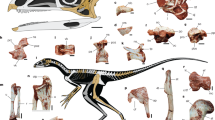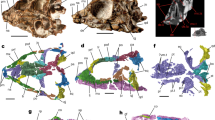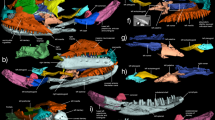Abstract
The first major adaptive radiation of reptiles consisted of the Synapsida, or mammal-like reptiles, which are now totally extinct, but which dominated the terrestrial fauna from the late Pennsylvania, throughout the Permian and for much of the Triassic periods. The mammals arose from advanced synapsids in the Upper Triassic, at which time the dinosaur reptiles were rapidly replacing the mammal-like reptiles as the principal terrestrial forms. The orthodox view1,2 of the ancestry of this important stage in vertebrate history is that the synapsids arose from a hypothetical stem-reptile of the family Romeriidae, the group closest to the ancestry of all the other reptile lineages. The principal difference between romeriids and the primitive synapsids is the development of a space, or temporal fenestra in the cheek region of the skull of the latter. However, the structure of this part of the skull of the romeriids cannot satisfactorily be considered ancestral to the synapsid temporal region on either comparative anatomical or functional grounds. As I propose here, the kind of skull which would be expected to evolve into that of a synapsid is the type possessed by the archaic ‘quasireptile’ Limnoscelis and its possible relative Romeriscus.
This is a preview of subscription content, access via your institution
Access options
Subscribe to this journal
Receive 51 print issues and online access
$199.00 per year
only $3.90 per issue
Buy this article
- Purchase on Springer Link
- Instant access to full article PDF
Prices may be subject to local taxes which are calculated during checkout
Similar content being viewed by others
References
Romer, A. S. & Price, L. W. Spec. Pap. Geol. Soc. Am. No 28, l–538 (1940).
Carroll, R. L. Biology of the Reptilia 1 (ed. A. Bellairs et al.) 1–44 (Academic, London, 1968).
Reisz, R. Bull. Mus. comp. Zool. Harvd 144, 27–62 (1972).
Carroll, R. L. J. Paleont. 43, 151–170 (1969).
Romer, A. S. Am. J. Sci. 244, 149–188 (1946).
Panchen, A. L. Studies in Vertebrate Evolution (eds Joysey, K. A. & Kemp, T. S.) 65–87 (Oliver & Boyd, Edinburgh, 1972).
Baird, D. & Carroll, R. L. Science 157, 56–59 (1967).
Frazzetta, T. H. J. Morph. 111, 287–320 (1969).
Langston, W. Tex. Mem. Mus. Bull. 9, 5–47 (1965).
Author information
Authors and Affiliations
Rights and permissions
About this article
Cite this article
Kemp, T. Origin of the mammal-like reptiles. Nature 283, 378–380 (1980). https://doi.org/10.1038/283378a0
Received:
Accepted:
Issue Date:
DOI: https://doi.org/10.1038/283378a0
This article is cited by
-
Phylogeny of the major tetrapod groups: Morphological data and divergence dates
Journal of Molecular Evolution (1990)
-
Origin of mammal-like reptiles
Nature (1980)
Comments
By submitting a comment you agree to abide by our Terms and Community Guidelines. If you find something abusive or that does not comply with our terms or guidelines please flag it as inappropriate.



